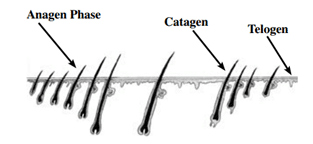Understand How Hair Grows & How it Contributes to Hair Loss Reasons
The root of the issue
Hair is far more complex than it seems. Hair starts growing by week 22 of a developing foetus although this hair is white as it has no pigment. At this stage, the foetus has about 5 million hair follicles on the body – one million on the head and about one hundred thousand on the scalp. It is in this stage that we have the most hair follicles that we will ever have as we will not generate any new hair follicles at any other time during our lives.
Shafts and Follicles
Hair is made up of a special protein known as Keratin which also forms the protective outer layer of our skin, fingernails and toenails.
Each strand of hair has three layers – the cuticle, the cortex and the medulla which protect the growing hair shaft. Each strand of hair consists of three concentric layers, the cuticle, the cortex and the medulla.
The cuticle is the outer layer of the strand whose job it is to protect the cortex which contains melanin (what gives your hair colour). The cuticle itself is thin and colourless as your hair’s colour depends on the type of melanin you have – eumelanin (which creates brown or black hair) or pheomelanin (which makes the hair red). Blondes have a low amount of melanin thus resulting in a lighter colour.
Whether you are blessed with straight or curly hair is dependent on the shape of your Cortex. If the shape of the cortex is round you will have straight hair and if the cortex is oval you will have curly or wavy hair. The cortex makes up the majority of the hair shaft.
The medulla is the innermost layer of the hair and as stated above, it gives the hair colour.
The hair shaft is what is visible above the scalp and the follicle is the part of the hair which resides in the skin. The hair follicle is a tunnel-like segment that extends down into the dermis. The follicle is protected by two sheaths – an inner and outer sheath. The inner sheath ends below the opening of a sebaceous (oil) gland which produces sebum – a conditioner for the hair and skin. During puberty, our body produces a large quantity of sebum which begins to decline as we age. The outer sheath continues all the way to the gland near the erector pili muscle – the muscle responsible for secreting oil from the sebaceous gland. At the base of the follicle is the papilla which contains tiny blood vessels called capillaries that provide nutrients to the cells. The living/growing part of the hair surrounds the papilla and is called the bulb. Every 24-72 hours the bulb divides, faster than any other cell in the body.
The average Caucasian person has 5 million hairs of which 100,000 – 150,000 are on the head. Blondes not only have more fun but they also have more hair, about 140,000 strands whereas Brunettes have approximately 105,000 hairs and redheads only have about 90,000 hairs. This hair grows about 0.3 to 0.4 mm per day and about 6 inches per year. However, there are several variables that can affect hair’s growth rate such as age, health, lifestyle, medications and genetics. Furthermore, hair growth rates vary across different areas of the head, with that on the crown growing the fastest for both women and men. Hair growth is most commonly analysed in its three stages – the Anagen, Catagen and Telogen phase.

Anagen
The Anagen phase is the active/growth phase of the hair in which hair grows about 1cm every 28 days. Scalp hair stays in this active phase of growth for two to six years as the cells in the root of the hair divide rapidly so that new hair is formed and pushes through the club hair (hair which is no longer in the Anagen phase of growth), up the follicle and out. However, the length of the Anagen phase can differ greatly, meaning that some people have difficulty growing their hair beyond a certain length as they have a short active phase of growth. Others have prolonged Anagen phases and so their hair grows much longer. This pattern of growth and variability also applies to people arm hair, leg hair, eyelashes and eyebrows.
Catagen
The Catagen phase usually lasts for about two to three weeks and signals the end of the active growth of hair. This phase is a transitional stage between the growth and resting phase and about 3% of all hairs exist in this phase at any time. During this phase, the follicle shrinks to about 1/6th of its normal length and attaches to the root of the hair. As the hair follicles slowly disintegrate they require less nourishment from the blood supply. This is the formation of what is known as a club hair.
Telogen is the resting phase of the hair growth stage and about 6% to 8% of all hairs remain in this stage at one time. This phase lasts for about 100 days and during this phase, the hair follicle is completely at rest and the club hair is completely formed. Lots of people get concerned during this phase as they notice that they ‘shed’ hair. However, it is normal to shed about 25 to 100 Telogen hairs each day so one shouldn’t worry! This ‘shedding’ phase is sometimes referred to as the ‘Exogen’ stage.
During these three phases, the physical thickness and length of hair depends on what type of hair you have – Vellus or Terminal hair. Vellus hair is the fine fuzz type of hair that is known colloquially as ‘peach fuzz’. Vellus hair is named ‘Peach Fuzz’ as it is very fine and colourless, often invisible to the human eye. Terminal hair is the hair we usually refer to – that dark thick hair that is clearly visible. Whether hair is fine Vellus hair or thick terminal hair depends on the follicle that produces the hair. When balding, most terminal hair is replaced by fine Vellus hair as the follicle has been affected by ageing or has suffered physical damage o from internal or external factors.
While we grow hair, we also lose hair due to genetics, age, stress, nutrition, hormones, medical conditions/medications and a whole host of other factors.
Stress
Studies have shown a strong correlation between stress/anxiety and hair loss. This is often exacerbated by the consumption of caffeine, alcohol and artificial sweeteners. Many practitioners in such cases recommend that people consume Vitamin B complex to strengthen their nervous system and help prevent white blood cells attacking the hair follicles which stop hair growth and make the hair fall out. So to prevent losing those luscious locks, take some time out – vitamins, yoga and long walks may do the trick!
Nutrition/ Minerals
Mineral imbalances also contribute to hair loss. This often occurs when people aren’t consuming enough mineral-rich foods such as raw or steamed foods. Cooked foods contain little to no minerals and mineral supplements aren’t always the answer as they can cause imbalances with the other minerals. So before you take any minerals without knowing your personal imbalances, a laboratory mineral and metal analysis could be beneficial as it would determine your personal levels and ratios. Metal toxicity is another factor that affects your mineral imbalances. Today, people consume more and more toxic metals, substances that come from your work conditions, water, food, beverages, cars and cleaning chemicals. Again, mineral/metal testing can provide you with an analysis of your personal levels of lead, mercury, arsenic, tin and aluminium. It’s usually higher than you think!
Hormones
Another main reason for hair loss is hormone imbalance. Hormones that affect hair growth/loss include testosterone, oestrogen, progesterone, cortisol, aldosterone and Dihydrotestosterone. DHT (a derivative of the male hormone testosterone) is the main culprit as it shrinks your hair follicles, making it impossible for healthy hair to survive. To maintain healthy hair, your hormones must be balanced. As a result, hair loss is often prevalent when hormones are at a high, e.g. for women following pregnancy or when they stop taking birth control medication. These events can all influence hair’s growth. As you all know, hormones are cyclical as men’s testosterone levels drop by approximately 10% each decade after age 30. Women’s hormone levels decline as menopause approaches and drop even further during/after menopause. During these hormonal peaks and troughs, hair loss is extremely common and many people turn to medication that has a balancing effect on their hormones or treatment for the subsequent hair loss. Nevertheless, it is a myth that men who higher levels of testosterone lose their hair at a younger age. This theory came hand in hand with the idea that male ejaculation causes testosterone levels to increase and more hair to fall out which is a complete fallacy.
Genetics
Androgenetic Alopecia is the most common form of hair loss, affecting 70% of men and 40% of women at some stage in their lives. Androgenetic Alopecia is ‘balding’ as a result of genes and androgens as the name suggests. The involvement of genetics is a complex matter. Some genes (such as the androgen receptor) are X-linked, chromosomes men get from their mothers. As a result, men resemble their maternal grandfather’s hair patterns more often than their fathers. But this is unlikely to the only factor and there are probably many other genes that cause baldness as men whose fathers are balding having 2.5 times the chance of experiencing hair loss themselves regardless of their mother’s side. Hoverer, some genes that determine hair loss aren’t sex-linked chromosomes and are known as autosomes which each parent randomly contributes to. So basically, scientists are still learning about the genetic intricacies behind hair loss but for now the best predictor for baldness is the androgen receptor gene a male gets from his mother.
Medications
Many modern-day medications can cause people to lose their hair. Telogen effluvium is the most common form of drug-induced hair loss. This stage occurs about 2 – 4 months after someone starts their medication. In this case, the medication makes the hair follicle go into the resting phase (telogen stage) too early, thus causing the hair to ‘shed’. The other most common type of drug-induced hair loss is Anagen effluvium – hair loss that occurs during the anagen phase (the active stage) of the hair cycle. In this stage, the medication prevents the matrix cells (that are responsible for producing new hair) from dividing normally. This occurs most commonly in people who are undoing Chemotherapy. Chemotherapy patients often note that they lose clumps of hair during treatment and some even lose all of the hair on their head, as well as their eyebrows, eyelashes and body hair. The drug and dosage of the medication affects the severity of hair loss. Some of the main medications that cause hair loss include Anti-depressants, birth control medication, high blood pressure medication, hormone replacement therapy, weight loss drugs, thyroid medications, epilepsy drugs (anticonvulsants) and steroids. Chemotherapy drugs that are used to kill cancer cells are particularly strong and hair loss is more common and severe in patients taking combinations of chemotherapy drugs such as Adriamycin, cyclophosphamide, cactinomycin and docetaxel.
Age
The presence of the necessary genes and hormones does not always cause hair loss. Hair loss often occurs due to age. Hair loss as we know is cyclical and does not occur in a steady, straight-line progression however we do know that with age, a person’s total hair volume will usually decrease. With age, most people’s hair begins to shrink in length and width within each follicular unit. As these hairs shrink, the area of hair begins to look ‘thinned’ out as the miniaturized hairs are very fine and clinically insignificant. Eventually, these miniaturized hairs disappear and the numbers of follicular units decrease. As you age, the hair breaks more quickly but fortunately, in most cases, the donor zone retains enough permanent hair that hair transplantation is a viable procedure even for a patient well into his or her 70s.

